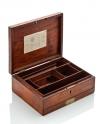  |
A PORTABLE WRITING BOX MADE FROM THE TIMBER OF THE 'FIGHTING' TÉMÉRAIRE, CIRCA 1840
with fitted compartments and lower paper drawer with inset handle, the lid with period paper provenance label stating the timber is from the riding bits -3¼ x 9¼ x 7¼in. (8.2 x 23.5 x 18.5cm.)
Téméraire (1798-1838) - originally known to her crew as the 'Saucy Téméraire' - achieved her greatest fame and praise at the Battle of Trafalgar. It was this battle which substituted 'Saucy' to The 'Fighting Téméraire': Second in the line after Victory, she fired a broadside upon the French 74-gun Redoutable which was in combat with Victory, checking a boarding attempt which the French were about to make. In response the top-men on Redoutable flung grenades and fire balls on Téméraire until her deck and stern were ablaze. Whilst an apparent cripple, a second enemy vessel, the French 80-gun Fougueux came to the starboard side determined to board her. The broadside Téméraire unleashed at less than 50 yards flung the French assault into confusion and, in the chaos, she crashed into Téméraire, was lashed fast and 28 men leapt aboard: within ten minutes British colours were hoisted. Subsequent famous images of Téméraire lashed on either side with her prize and Victory's prize set her firmly in the nation's affections, but perhaps the most famous picture associated with her is Turner's affectionate yet wistful canvas which depicts her under the tow of a smoking steam tug, out dated and on her way to the Beatson's breakers yard where much of her timber was sold for building work, and small souvenirs such as this box.
£1000-1500
|
|

|
A FOUDROYANT TIMBER HALL CHAIR, CIRCA 1898
the shaped back carved with life buoy with banner inscribed Foudroyant and the date '1798-1897' above, the reverse of the backrest inscribed 'Vere', foliate etching to seat and turned legs joined by an H-stretcher, - 37½in. (95cm.) high
£400-600
|
|
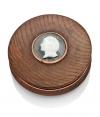   |
A GOLD MOUNTED SNUFF BOX MADE FROM THE TIMBER OF H.M.S. VICTORY, EARLY 19TH-CENTURY
the lid with profile of Nelson formed of Tassie's compound with disc inside inscribed 'From / Lt GENERAL HAY, / to his Friend / A. LEITH ESQr. / of / Freefield' with further roundel on underside inscribed 'Form'd / from a Splinter / H.B.M.S. / Victory / Commanded by / LORD NELSON. / Trafalgar / Octr. 21. 1805' - 3in. (7.5cm) wide
£1800-2500
|
|

|
'H.M.S. VICTORY: BUILDING, RESTORATION & REPAIR'
by Arthur Bugler for H.M.S.O. London 1966, 382 pages with detailed technical diagrams, photographs and descriptions, bound in blue cloth boards with wrapper; together with a complete set of accompanying plans contained in blue cloth box with wrapper, both contained in original card outer case with H.M.S.O. label, boxed measurement - 11½ x 9¼in. (29 x 23.5cm.)
(2)
£100-150
|
|

|
DEATH OF NELSON, 21st OCTOBER 1805
a rare and early Osborne plaque depicting the death of Nelson in the cockpit of H.M.S. Victory, handmade in plaster, finished with wax and then hand-painted in shades of brown, marked AO (for Arthur Osborne), 19 x 24in. (48 x 61cm.), as made and attractively mounted in a deep, glazed frame case for display
Osborne plaques were produced in Faversham, Kent, from 1899-1965. The business was founded by Arthur Osborne and all plaques were marked 'AO' until his death in 1943. There are considerable colour variations but those which were predominantly painted in brown all pre-date 1930. The plaques invariably depict well-known buildings, historical events or famous personalities. The usual size is normally in the region of 6 x 9in but are often even smaller. No example depicting any subject of a size comparable to the one offered here has been discovered by the cataloguer, and it seems very likely that it was a special commission for the Trafalgar centenary celebrations in 1905
£400-600
|
|
 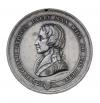 |
Nelson Testimonial Medal, 1844
in white metal by E. Avern, bust of Nelson left within garter bearing ENGLAND EXPECTS.. etc, rev., Trafalgar Square and Nelson's Column; inscribed TO COMMEMORATE THE OPENING OF THE NELSON TESTIMONIAL TRAFALGAR SQUE - 21 OCTOBER 1844 - 2½in. (6.1cm.)
Hardy, T.A., Remember Nelson, Spink, 2005, p.61, no. 97
Testimonial Medals such as this were presented to 357 Greenwich Pensioners who had served at one of Nelson's four major actions, those of St. Vincent (39), Nile (35), Copenhagen (45) and Trafalgar (238), together with a gratuity of ten shillings, at a ceremony held at the Royal Greenwich Hospital on 2nd April 1845. The awards were funded by the Testimonial Committee of the parishioners of St. Martin-in-the-Fields. For more details see Captain Douglas-Morris: Naval Medals, 1793-1856, pp. 49-53. He knew of fewer than ten surviving medals, one of which was paired with an NGS medal
£500-700
|
|

|
DEATH OF NELSON, BRONZE MEDAL BY THOMAS WEBB, 1805
after John Flaxman, bare head of Nelson left, rev., Bellona stepping across waves towards war galleys - 2¼in. (5.5cm.) diam; together with another similar.
(2)
Hardy, T.A., Remember Nelson, Spink, 2005, p.40, no. 63
£300-400
|
|

|
A COMMEMORATIVE SILVER VESTA CASE, CIRCA 1886
decorated in scrollwork overall with applied enamel portrait of Lord Nelson to front, hallmarked for Howard James, Birmingham, 1885-6 - 2¼in. (5.7cm.) high
£100-150
|
|

|
'ORAZIO NELSON'
possibly after Carmelus Argento, circa 1800, printed on laid paper with inscription Conto Ammiraglio della Scquadra Blu / e Cave: del Insigne del Bagno, plate - 11½ x 7in. (29 x 18cm.)
£30-50
|
|

|
Cook, Captain James: The Journals
four vols, plans and charts. Cambridge, University Press, 1955-67. With seven off-prints edited by J.C. Beaglehole; Skelton and others, Charts & Views Drawn by Cook and his Officers, folding charts, a few missing, in blue portfolio with ties, Ibid 1955; Beaglehole, J.C., The Life of Captain James Cook, a few portraits. London, The Hakluyt Society, 1974.
(13)
£100-150
|
|

|
BLIGH, WILLIAM: 'Capitainens vid EngelSke Ammiralitetet Wiliam Bligh's ReSa i SÖderhafvet Åren 1788, 1789, 1790. Hans half-arige Vistande pÅ On Ö-Taheiti'
original stiff wrappers, uncut, book plate of S.J. Walters. 8vo, Nyköpimg, J.P. Hammarin, 1795
First Swedish edition of Bligh's epic journey from Tahiti to Timor
£400-600
|
|

|
THE SPITHEAD MUTINY, 1797: AN INFORMANTS LETTER TO LORD HOWE
a manuscript letter tightly written over four sides of a single folded sheet of laid paper watermarked for Cortlis & Sons / 1796 and addressed to an un-named retired Lord who was reporting to the King and giving background intelligence and "news" as heard on the street including details of the ring leader, Richard Parker, and the main causes for their grievances The itch of news my Lord is the general disease of the Town. I can not say I am possessed with it not further than a wish I have to collect something worth sending to your Lordship... Was your Lordship in active Life I would not presume to Obtrude on your thoughts but I have an excuse in wishing a moment of amusement in your retirement. signed and dated V.V. June 8th 97 - 9 x 15in. (23 x 38cm.) open
The identity of the recipient is almost certainly Lord Howe - only recently retired, he was rowed from ship to ship and settled the mutiny before it spread out of control and whom the press reported was to have an audience with the King. The sender - 'V.V.' - remains a mystery and seems to have been a self-appointed spy, able to circulate around the taverns and streets without notice.
£200-400
|
|
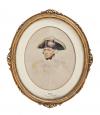 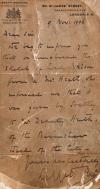   |
AFTER LEMUEL FRANCIS ABBOTT (BRITISH, 1760-1803)
Nelson - A Gridded Study
Watercolour and pencil on card, bears inscription Robert Southey 27 July 1830 (lower left folded corner on reverse), mounted as an oval with manuscript provenance labels for Leggatt Brothers to reverse
9 x 7½in. (23 x 19cm.) unmounted
Provenance: Sotheby's Marine Picture & Nautical Works of Art Sale, 3rd May, 1995, lot 1.
Literature: Walker, R: The Nelson Portraits, Royal Naval Museum, 1998, p.31 & 206; Slope, N: Nelson's Chelengk, Nelson Society Dispatch, Vol II part 9 Winter 2014, p.535-549
The label from Leggatt Brothers is dated 9th November 1906 and reads: Dear Sir, We beg to inform you that we purchased the sketch of Lord Nelson from a Mr Heath, who informed us that it was given by Southey to Mr. Deputy Heath, of the Bassishaw Ward of the City ' Yours respectfully.
Bassishaw Ward is the smallest of the twenty-five wards who provides an Alderman to their Court at Guildhall. The second label attributes Southey's ownership until 1830 and states that it was used as a frontispiece in his Life of Nelson - in fact, it was the head study by Simon de Koster which was used.
£300-400
|
|

|
Ø ENGLISH SCHOOL, CIRCA 1845
Admiral James Saumarez (1757-1836)
Oil on ivory
Monogrammed and dated 'SS 1845' (lower left)
6 x 4in. (15 x 10cm.)
£400-600
|
|
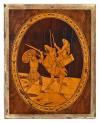 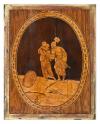 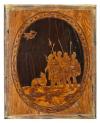 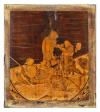 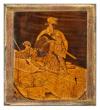 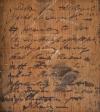 |
A SET OF FIVE MARQUETRY PANELS FROM THE ROYAL YACHT ROYAL CHARLOTTE, EX-ROYAL CAROLINE, CIRCA 1750
walnut with ink lined satinwood inlay depicting scenes from Homer's Illiad, framed within feigned oak leaf ovals, one inscribed on the reverse Taken from the Royal Yacht of George 3rd. Presented to Mr. B. Tuckness of Deptford Dockyard during that Kings Reign with other similar inlaid pictures representing combats in the Trojan War - one of [a] of a series of illustrations from Homers Illiad ' , another with applied manscript provenance, two now cut down - 14 x 11in. (35.5 x 28cm.) and 8½ x 7in. (21.5 x 18cm.) mounted on gilt supports for wall hanging.
(5)
Provenance: Bartholomew Tuckness; Charlotte Tuckness (wife of Charles Tuckness) to Rev. J. Salwey, Broxbourne, April 1892; US Private Collection.
Bartholomew Tuckness (1750-1822) was a joiner located in King Street, Deptford, who founded the firm of Tuckness & Huntley. It seems he was employed by the yard before founding his firm and retained strong connections, the Royal Charlotte being broken up at Deptford in 1820 having been laid up since 1804.
Royal Caroline, principal yacht to King George II and named in honour of his wife Caroline (of Ansbach), was built at Deptford by Mr. J. Allin in 1749. Designed as a sixth-rate mounting 10-3pdrs. and 8-pdr. swivel guns, she was measured at 232 tons burden with a 90 foot gundeck and a 24 foot beam. The largest royal yacht to date and the only such vessel to exceed 200 tons until Royal Sovereign was launched in 1804, she was one of the most sumptuous and expensively decorated vessels ever constructed. Whilst the Admiralty had ordered her, they had not budgeted for her and the niggling correspondence that ensued throws interesting light onto the lavish decor - nearly £1200 for carvings with 120,000 sheets of gold leaf costing a further £1521; £200 for curtains and silks; £18 for the stern lantern and numerous other expenses. A note sent by a carpenter called John Bladwell, sent to George Jackson of the Navy Office from March 1750 may mention, in part at least, the lot offered here: Sir - I was favour'd with yours[.] the hanging for his Majesty's Room is gone Down and the other 21 Panels will all be finished Satterday [sic] Morning without fail. At that time a typical seaman received £12 per annum and her full ship rig required a crew of 70 men to handle. George II's frequent visits to Hanover meant that she was in constant use ferrying him to and from the continent and she remained a firm favourite with the King until his death in 1760. When the new King, George III, chose Princess Charlotte of Mecklenburg to be his Queen, Royal Caroline was renamed Royal Charlotte in her honour and was the obvious vessel to convey the new bride to England. After the Princess Augusta was launched in 1771, Royal Charlotte lost her place as the most favoured royal yacht but continued in service. The Napoleonic Wars curtailed her use however and other than carrying the King on the occasional holiday trip to Weymouth between 1801-04, she was mostly laid up at Deptford and finally broken up there in 1820 where presumably a quantity of her fittings were sold off - it's no surprise an established supplier such as Mr Tuckness was able to acquire these very rare souvenirs which give a small hint of the quality alluded to in the Admiralty correspondence.
£3000-4000
|
|
   |
A RARE CRIMEAN WAR RUSSIAN NAVAL ENSIGN AND SWALLOW-TAILED ANSWERING PENNANT, CIRCA 1855
both comprising hand-stitched bunting panels of edged blue and white with canvas sleeves, the upper hem of the ensign bearing a sewn panel reading This Russian Ensign and Ansg. Pendant [sic] was taken from one of their boats at Sebastopol, by Mr. W.H. Cruys, CBM of H.M.S. Albion on the 9th (altered by hand to the 10th) Sept. 1855, the larger - 33 x 49in. (84 x 125cm.)
(2)
At 3,111 tons, H.M.S. Albion was the largest 2-decker sailing ship built for the Royal Navy and the only example of her type designed by the controversial Sir William Symonds. Laid down at Plymouth in 1839 and launched in September 1842, she served first in the Channel Fleet (from 1843-48) and thereafter in the Mediterranean from 1849. One of the last sailing ships to see significant action, she was so badly damaged at the first bombardment of Sebastopol (17th October 1854) during the Crimean War that she had to be towed out of the line of battle and taken to Malta for repairs, returning to the Black Sea the next year. Although converted to screw propulsion in 1860-61, she never put to sea as a steam ship and was broken up as obsolete in 1884
£400-600
|
|

|
A MARINE-THEMED MARQUETRY ESCRITOIRE, CIRCA 1850
the lid depicting the fleet departing Spithead bound for the Baltic on 11th March 1854, the interior with tooled leather writing slope, typical fittings and accessories - 6½ x 17 x 10¼in. (16 x 43 x 26cm.)
£250-400
|
|
|
|

|
An historically interesting standish, carved from timber recovered from the wreck of H.M.S. Lutine
the central inkwell with cover supported by three dolphins within circular dish with foliate border, the inkwell with white metal plaque engraved THIS INKSTAND / is made of the / RUDDER of LUTINE Frigate wrecked off the island of Vlieland Octr. 9 1799 / The Rudder was recovered in 1859 / after being submerged 60 years, flanked by two carved sets of arms for the City of London - 7 x 10½in. (18 x 26.8cm.)
The Lutine, a prize taken in 1793, was a 5th rate of 32-guns. She was wrecked on a bank near Vlieland, Holland in 1799 with a vast fortune in gold aboard. Much of this was subsequently recovered over a period of years, along with artefacts including her famous bell, which now hangs at Lloyds of London and is rung every time a ship insured by them founders
£700-900
|
|

|
A CAST BRASS TOMPION FROM THE ARMOURED CRUISER H.M.S. COCHRANE [1905]
depicting the family crest of the Cochrane family, with threaded barrel mounts behind, - 10in. (25.5cm.) diam
One of four Warrior Class ships ordered in 1903-4, they displaced some 13,500 tons, but were effectively obsolete after the 1906 introduction of Dreadnought. Cochrane was never-the-less assigned to the Grand Fleet in 1914 and served at Jutland - albeit without firing a shot. On 14th November 1918 she was stranded in the Mersey whilst under pilot and broke her back.
£250-350
|
|
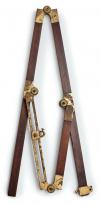  |
AN INTERESTING INCLINOMETER APPARENTLY PRESENTED TO ADMIRAL LORD CHARLES BERESFORD, CIRCA 1900
unsigned, with 6½in. brass dial engraved with a depiction of the 2nd Class cruiser Undaunted, the Royal Arms allied to the Royal House of Denmark, flanked by Britannia and a Lion Rampant, the indicator needle counter balance monogrammed 'CPB', set within rope-bordered frame with securing lugs - 14in. (35.5cm.) diameter
Admiral Lord Charles Poer Beresford (1846-1919) was a colourful and highly popular Admiral with the British public who affectionately called him 'Charlie B'. He won their devotion early on in the Egyptian campaign of 1882 when, in Command of the Condor he took his ship inshore to bombard the batteries with great effect. The flagships signal "Well Done Condor" reverberated around the fleet and sealed Beresford's reputation. The latter part of his career however was spent in a bitter feud with Sir John ('Jackie') Fisher whose modernising reforms were to become essential in World War One and who prevented Beresford from attaining the rank First Sea Lord. He commanded H.M.S. Undaunted from her launch in 1889 until 1893 and it seems likely that this inclinometer was presented to him by his old messmates as an in-joke in 1907 when he took command of the Channel Fleet where he "lived with great style" aboard the Flagship H.M.S. King Edward VII - using patriotic symbols including those of the King with whom he had dramatically fallen out with in 1891 over an affair with the Countess of Warwick.
£400-600
|
|

|
Ø A PAIR OF TURNED IVORY SPEAKING TUBE TERMINALS, BY TRADITION THOSE CONNECTING THE CABINS OF QUEEN VICTORIA AND PRINCE ALBERT ABOARD THE R.Y. VICTORIA & ALBERT II
each with threaded pipe connector, indicator rod and removable whistle - 4in. (10cm.) high
(2, a pair)
£800-1200
|
|

|
FOUR ITEMS OF BLUE AND WHITE WARE FROM THE R.Y. VICTORIA & ALBERT III, CIRCA 1910
by Spode Copeland, comprising dinner plate; coffee can; and two saucers (one cracked), each with gilt-highlighted device for Royal Yacht and maker's mark to base, plate - 10¼in. (26cm.) diam
£400-600
|
|

|
A GIMBALLED CANDLE LAMP, BELIEVED TO BE FROM A ROYAL YACHT
with maker's label for 'Norie & Wilson' on outer gimbal bracket, in plated metal, the sprung candle socket with lead counter weight, glass shade with separate protector and wall bracket - 13in. (33cm.)
£200-400
|
|

|
A LIFEBUOY FROM THE R.Y. ALEXANDRA (1908)
cork-filled canvas painted white with polychromed crown and inscribed in gilt lettering "ALEXANDRA" with grab rope surround - 31in. (79cm.) diameter
The 2050 ton R.Y. Alexandra was built by A.& J. Inglis, Glasgow, named after Edward VII's consort, and intended to escort and supplement the work undertaken by the main Royal Yacht, Victoria & Albert III, which she did the year she was launched on a State visit to Russia. Serving as a hospital ship in WWI, by 1925 it was too expensive to justify two Royal Yachts and she was sold to the Norwegian Shipping Co. of Trondheim for £25,000 and converted to a cruise ship. She was sunk during the German invasion of 1940
£300-400
|
|
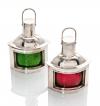 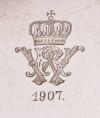 |
A PAIR OF NOVELTY SILVER CIGARETTE HOLDERS FROM THE KAISER'S RACING YACHT METEOR III, CIRCA 1907
modelled as port and starboard navigation lamps, each with green or red glass and match strike, the tops hinged to reveal gilt-lined cigarette compartment with match compartment in 'ventilator' over, each stamped on their bases with the Kaiser's monogram and dated '1907', Continental '800' mark and maker's name M. Hansen, Kiel, each - 5½in. (14cm.) without handle
Built by Townsend & Downey Shipbuilding Co., on Shooter Island and designed by H. G. Barbey & A. Carey Smith, the Kaiser's third Meteor was launched on February 25, 1902 - christened by Alice Roosevelt, the U.S. President's wife. Sadly, her racing record was not impressive and, after persevering for several seasons, she was sold in 1909 to be replaced the the fourth, and last, Meteor, and upon which these attractive novelties were no doubt also used.
£1500-2000
|
|
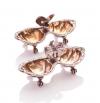 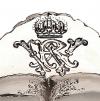 |
A PAIR OF SILVER SALTS FROM THE GERMAN IMPERIAL STEAM YACHT HOHENZOLLERN II, CIRCA 1893
comprising two gilt-lined bowls on ball-and-claw feet conjoined with an Imperial eagle handle, engraved on lower left edge with cipher for Wilhelm II and impressed with maker's marks for 'D. Vollgold & Söhne' - 2 x 4½in. (5 x 11.5cm.)
The Royal Yacht Hohenzollern II was launched in 1893 by the shipbuilder A.G. Vulcan in Stettin, which was at that time part of the Prussian Empire. She measured a vast 122 meters in length with a width of 14 meters. Dwarfing her British equivalent, she became a regular sight during Royal Cowes Week where the Kaiser hosted receptions aboard her with German military bands contrasting sharply with Prince (later King) Edward's informal string quartets playing popular music hall songs on the Squadron's lawns. She also served something of a dual purpose being both a recreational and a naval command vessel, combining lavish interiors with special cannons which had been a gift from the renowned industrialist Alfred Krupp. In June 1914 the Kaiser was aboard her for his summer cruise in the Norwegian fjords when he learnt about Sarajevo. Laid up from the end of July, she was never used again and was scrapped by the Weimar Republic in 1923
£400-600
|
|
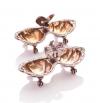 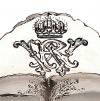 |
A PAIR OF SILVER SALTS FROM THE GERMAN IMPERIAL STEAM YACHT HOHENZOLLERN II, CIRCA 1893
comprising two gilt-lined bowls on ball-and-claw feet conjoined with an Imperial eagle handle, engraved on lower left edge with cipher for Wilhelm II and impressed with maker's marks for 'D. Vollgold & Söhne' - 2 x 4½in. (5 x 11.5cm.)
£400-600
|
|
 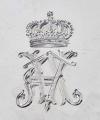 |
FOUR YACHTING TABLE SILVER NOVELTIES
all modelled as navigation lamps and comprising a pepper pot inscribed Steuerbord and engraved with Imperial German cypher for 'AV' under, hallmarked for 1906-7; a table vesta (1901-2); a flask inscribed 'HWB' under ventilator 1911-12); and a cigar lighter (1922-3), all approximately - 3½in. (9cm.) high
(4)
£800-1200
|
|

|
A LT. COMMANDER'S FULL DRESS UNIFORM FOR THE ROYAL NAVY, CIRCA 1920
by Gieves, Matthew & Seagrove and comprising bicorn hat with bullion tassles, epaulettes, sword belting, kid gloves, laced trousers, full dress tail coat and boat cloak, contained in two regulation tin trunks inscribed for 'A.G. Davidson, RN', together with three service medals from the Great War comprising the 1914-15 Star, British War Medal 1914-20 and Victory Medal
(3)
Alastair Gordon Davidson (1893-1974) entered the Service in 1906 as a Midshipman, spent WWI as a Sub Lt, promoted Lt in 1916 and Lt Cdr in 1924. He is thought to have served in H.M. Ships Seraph, Wessex, Wakeful and Viceroy during the 1920s as a Lieutenant Commander. He left the navy in 1936 as a Commander but then was recalled during WWII, appointed Captain and commanded the training ship Cardiff from 1942 to 1944
£400-600
|
|

|
A ROYAL NAVY DIRK, CIRCA 1915
of standard pattern, with 18¼in. etched blade, tanned snakeskin wire-bound grip, regulation hilt and scabbard with sprung retaining clip - 25in. (63.5cm.) overall
The use of tanned snakeskin for the grip, in place of the usual fish skin, is unusual and may have been a Wartime expedience forced upon the cutlers.
£100-150
|
|

|
A 1920s MODEL GUN TURRET FROM METAL OFF THE SCUTTLED IMPERIAL GERMAN BATTLESHIP HELGOLAND
the well-made model fashioned as an inkstand in the form of a revolving gun turret, the inner lid marked "Cast from Metal ex-surrendered German Battleship Helgoland", Thos. W. Ward Ltd., Sheffield, 1922, with two aluminium ink reservoirs, an attractive item, extreme width - 7½ins. (19cms.)
Helgoland was the nameship of a small class of three battleships and one battle-cruiser ordered for the Imperial Navy during the celebrated Anglo-German 'Arms Race' of the early 20th century. Built at Kiel, Helgoland herself was 549 feet in length with a 94 foot beam and displaced 25,200 tons deep loaded. With a main armament of 12-12in. guns, she could cruise at 20 knots and must have been a hugely impressive sight at full speed. In action at Jutland, in Vice-Admiral Schmidt's 1st Squadron, she was interned at Scapa Flow when the High Sea's fleet surrendered after the November 1918 Armistice. Laid up idle for six months, Helgoland was scuttled along with the rest of the fleet on 21st June 1919, after which began the famous salvage operation which lasted throughout the 1920s
£300-400
|
|
| |
NAPOLEONIC WARS: CAPTURE OF THE CAPE OF GOOD HOPE
The Dutch Government, having not only rejected…the proposals…that the Settlement should place itself under the protection of Great Britain…(and) having acted in a manner demonstrative of such hostile disposition towards us…The Admiral and myself concurred in thinking it expedient to prevent the execution of his purpose, by landing ourselves, and taking possession of the place…, a collection of excellent and lengthy front page reports from Vice-Admiral Sir George Elphinstone, and Major Generals Clarke and Craig, all pertaining to the invasion and capture of the Cape of Good Hope, a Dutch colony, that became the enemy of the British during the Napoleonic Wars after becoming vassals of the French, includes the articles of capitulation, and lists of killed and wounded - 183 cm. of column space, page 1 columns 1-3, and page 2, columns 1-2, in a complete and origianal issue of THE LONDON EVENING POST, for 26 November, 1795
£200-300
|
|
| |
THE BATTLE OF CAMPERDOWN
Admiral Duncan's Official Account of the Victory over the Dutch Fleet under Admiral de Winter off Texel: The Venerable soon got through the enemy's line, and I began a close action, with my division on their van, which lasted nearly two hours and a half, when I observed the masts of the Dutch Admiral's go by the board; she was, however, defended for some time in the most gallant manner; but being pressed by numbers, her colours were struck, and Admiral de Winter was soon brought aboard the Venerable... with lists of killed and wounded, battle order, ships taken, etc. (back page, col 1-2, 55cm. of column space); also in separate articles: medallions similar to those presented after the Glorious 1st of June to be presented; a slightly wounded woman manning one of the guns positively refused to quit her quarters until forced below for attention; Dutch accused of using stink pots, a horrid system of warfare long abandoned; Nelson presided at a meeting of Naval Officers at the Shakespeare Tavern (pages 1 & 2, 28 cm. of column space), all in a complete and original issue of THE OBSERVER, dated 22nd October, 1797
£250-350
|
|
| |
NAPOLEONIC WARS: CAPRI CAPITULATES TO THE BRITISH
The Commandant of Capri to Rear Admiral Sidney Smith: I received, Sir, your letter dated this day, and for answer, I have to observe to you, that a true soldier does not surrender until he has tried his force with that which attacks him. You, Sir, are too good and brave a soldier to blame me if I do not accept your polite invitation… an excellent and lengthy article by Admiral Sidney Smith, covering the Naval and land actions surrounding the Battle of Maida, and the capitulation of the French garrison at Capri.
Included are the letters between the garrison commander L'Etang, and Sidney Smith, as well as the conditions of surrender, letters from Richardson of the Juno, and others to Sidney Smith, and lists of killed and wounded, in all - 116cm. of column space, page 2, columns 1-3; also: Captain Lavie Captures La Guerriere: Report from Captain Lavie of the Blanche, to the Admiralty Office of his naval action off Greenland and subsequent capture of the frigate Guerriere. The Blanche managed to deliver two broadsides before the Guerriere realized she was not an ally, the capture of which earned Lavie a Knighthood - 18cm. of column space, page 2, column 1, in a complete and original issue of THE CALEDONIAN MERCURY, for 2nd August, 1806
£200-300
|
|
 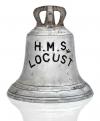 |
AN HISTORICALLY INTERESTING SHIP'S BELL FROM H.M.S. LOCUST (1939)
nickle-plated with black filled lettering, regulation crown top and red painted interior (lacks clapper) - 11in. (28cm.) high
Launched by Yarrow of Scotstoun and completed in 1940, Locust was one of four 'Dragonfly' Class river gunboats. Displacing 715 tons (deep load), they measured 196ft 6in., steamed at 17kts and carried a crew of 74. Relatively lightly armed with two 4in. quick-firing guns and one 3.7in. howitzer, Locust was later augmented with three 20mm. and twenty depth charges. In August 1942 she played a lead rôle in Operation Rutter - better known as the Dieppe Raid or the Battle of Dieppe. Commanded by Robert Ryder (who in March had participated in the very successful St. Nazaire Raid), the Dieppe Raid contrasted poorly - of the 6000 allied (mostly Canadian) troops landed, including 200 Commandos from Locust, 3,367 were killed or wounded on the beaches. The Royal Navy lost thirty-three landing craft and one destroyer, the Royal Air Force 106 aircraft, mostly to flak, compared with just 46 of the Luftwaffe. The sober lesson learned was that the Allies could not hope to invade mainland Europe for a long time, but when Operation Overlord was finally put into practice in 1944, Locust participated and, despite being hit by shellfire, survived the War. She was decommissioned in May 1946 and placed in reserve, being sold for breaking at Newport in 1968.
£700-900
|
|
| |
A LATE 19TH-CENTURY NAVAL CROWN SWEETHEART BROOCH,
of typical form with band of seed pearls, stamped to reverse 15ct DELACOUR [of Chatham], - 3.4g.; 20mm wide, contained in plush-lined case
£200-400
|
|

|
A 15CT GOLD AND ENAMAL NAVAL SWEETHEART BROOCH, CIRCA 1932
modelled as a fouled anchor flanked with wreaths and royal crown over, mounted on a bar brooch with safety catch, stamped 15 to reverse, in a fitted case stamped Gieves London - 4.5g, 1¾in. (4.5cm.)
£200-400
|
|
| |
A WHITE GOLD AND DIAMOND NAVAL SWEETHEART BAR BROOCH
by Gieves of London Ltd, circa 1920
the central crown set with diamonds and mounted on a plain bar with pin and safety catch behind, - 4.6g, 2¾in. (7.5cm.), in plush lined fitted box with retailer's mark to lid
£200-400
|
|
  |
CAPTAIN HANS LANGSDORFF'S NAVAL DRESS SWORD
Kaisermarine pattern, the 29½in. pipe-backed blade stamped with maker's mark for F.W. Höller, Solingen, regulation half-basket hilt inscribed on the hinged thumb-piece Kpt. Z. See Langsdorff, contained in leather scabbard of issue - 35½in. (90cm.) overall
Provenance: Phillips Glendinings, London, Arms & Armour Sale, 26th March, 1998, lot 1064: Acquired by vendor in lieu of a debt, from a German engineer in Buenos Aires in 1957
Captain Hans Langsdorff, born at Bergen on the Baltic island of Rügen in 1894, spent much of his youth in Düsseldorf before joining the Imperial German Navy in 1912. After active service during WWI, he remained in the navy and ultimately became a torpedo specialist before accepting a senior administrative appointment with the Reichsmarine. Proving equally capable behind a desk, he was an obvious choice to command the new cruiser Admiral Graf Spee when she completed in 1936, a commission which eventually ended with him being accorded that remarkable reputation for chivalry in war which not only made him a household name at the time, but which has now endured for over 50 years
When WWII broke out on 3rd September, 1939, the 'pocket battleship' Graf Spee was already in the South Atlantic although, despite Germany's invasion of Poland on 1st September, Hitler was initially convinced that Great Britain and France would negotiate for an early peace. To this end, he kept German warships away from the commercial shipping lanes as he awaited developments and Graf Spee stood off the South American coast in company with her supply ship Altmark for almost three weeks before finally receiving orders to assume the offensive. On 20th September Langsdorff sank his first victim, the Booth Line's steamer Clement, 60 miles off Pernambuco, and in just over two months, he sank a further nine British merchantmen. His dislike of unnecessary bloodshed however, coupled with the extraordinarily humane treatment of his prisoners whom he put aboard Altmark, earned him the grudging respect of even those captains whose ships he had sunk beneath them although it was not until Altmark herself was captured off Norway the following February that the full story emerged. The Admiralty meanwhile, realising that Langsdorff had to be stopped as much to allay public concern at home as to prevent further shipping losses, mounted an urgent operation to hunt and destroy Graf Spee as rapidly as possible. Commodore Henry Harwood, Senior Royal Navy officer in the area, was given command and his flotilla - designated Force 'G' - consisted of the heavy cruiser H.M.S. Exeter and two light cruisers, Ajax and Achilles, the latter seconded from the Royal New Zealand Navy. In theory at least Force 'G' was easily capable of dealing with a single enemy heavy cruiser; in practice however, the considerable strengths of the so-called 'pocket battleship' were such that Harwood knew he faced a formidable task even allowing for the fact that he would first have to locate Graf Spee and corner her somewhere in the vastness of the South Atlantic
Intuition suggested the wide estuary of the River Plate, a vital crossroads for many South American trade routes, and Harwood's fitness for command soon proved itself when Force 'G' sighted the smoke of an unknown vessel on the horizon early on the morning of 13th December. Exeter approached to investigate and instantaneously with Harwood's confirmation that the stranger was indeed Graf Spee, Langsdorff had spotted his pursuers, rung up 'battle stations' and was steaming into action at full speed. Harwood wisely divided his force so as to minimise the effects of the enemy's main armament but not before all three of his ships had become targets. Langsdorff opened fire at approximately 6.20am. and concentrated his port salvoes on Exeter whilst his starboard guns dealt with Ajax and Achilles. Exeter bore the brunt of accurate German gunnery and by 7 o'clock she had received between 40 and 50 hits and lost two turrets. Half an hour later, her last turret was silenced and she was forced to withdraw from the action, severely damaged and with heavy casualties including 53 dead. The light cruisers fought on obstinately, despite the overwhelming odds, and even though they too were damaged - especially Ajax - their dogged tenacity probably saved Exeter and decided the outcome of the battle. Unknown to them, Langsdorff had become concerned that he was vulnerable to a combined torpedo attack and that fear, coupled with the realisation that Graf Spee had actually been hit 20 times by British shells, provoked a surprising reaction and he broke off the engagement to run for shelter in the Plate Estuary 300 miles to the west.
Racing past and ignoring a homeward-bound British merchantman the Shakespeare, Graf Spee made the neutral port of Montevideo after a 12 hour dash pursued by Ajax and Achilles. Britain immediately requested the Uruguayan authorities to expel Graf Spee within 24 hours or intern her under the provisions of International Law, thereby initiating a frenzied burst of diplomatic activity worthy of the most popular fiction. Despite the best efforts of both Langsdorff and the German Ambassador, the permitted stay was only extended to 72 hours and Langsdorff, surrounded by rumours of approaching British reinforcements, was faced with a bitter choice. As the 8.00pm. deadline neared on 17th December, Langsdorff took his second fateful decision and having released the few British prisoners still aboard his ship, and bidding farewell to those who had given him sanctuary in Montevideo, ordered Graf Spee to make ready to sail. Clearing her moorings at 6.15pm., she made for the open sea followed by the German steamer Tacoma. With her battle ensigns flying, she stopped engines at the three mile limit and there, in full view of Ajax and Achilles, she suddenly and unexpectedly blew up and destroyed herself with pre-set explosives. Her crew were taken aboard Tacoma which proceeded to Buenos Aires where, on 20th December, Captain Langsdorff took his own life rather than face the ignominy of surrender and internment.
It was a tragic end for a man who, by then, had earned the admiration of those who were hunting him down as well a those who had suffered loss at his hands. To many he epitomised the chivalry of an earlier age and even though he had sunk over 50,000 tons of British merchant shipping, not a single allied life had been lost aboard any of those vessels. In fact, his conduct throughout the Graf Spee's final commission was such that he was, and still is, universally regarded as one of the last gentleman raiders in the history of war at sea
Admiral Graf Spee, the third of the 'Deutschland' class cruisers [the so-called 'pocket battleships'] was laid down in 1932, launched in 1934 and completed in January 1936. Displacing 11,700 tons, she measured 610 feet in length with a 71 foot beam, and could make 28 knots under full power. Her design, as a fast heavily-armed though lightly-armoured long-range merchant raider, proved a triumph and had all eight of the class been built instead of three which were completed, the Royal Navy would probably have faced an impossible task given that it had only three capital ships capable of matching their speed
£4000-6000
| Fittings & Collectables | |
|

|
A FINELY CARVED EARLY 19TH-CENTURY 'BUGBEAR' CARVED COCONUT FLASK
carved in the round with young couples drinking amongst vines, with typical bearded face yawing to top and white metal mask handles to each side - 5in. (20.5cm) high
£400-600
|
|

|
A FINELY CARVED EARLY 19TH-CENTURY 'BUGBEAR' COCONUT FLASK
carved in the round with hunting and musical motifs, the mouth typically carved with a bearded mouth and garland underneath, - 5in. (12.5cm.) high; together with a coconut cup engraved in the round with botanical motifs
(2)
£400-600
|
|

|
A FINELY CARVED EARLY 19TH-CENTURY 'BUGBEAR' COCONUT FLASK
carved in the round with roundals comprising Britannia, a swag of musical instruments, (?) a French cockerel and serpent, the end with typical yawing bearded face with glass eyes, - 5in. (12.5cm.) high; together with a small coconut inscribed to Rosa de Roboletto decorated with patriotic motifs
(2)
£400-600
|
|

|
AN EARLY 19TH-CENTURY CARVED COCONUT FLASK AND STAND
incised in the round with patriotic symbols comprising the UK crown, a thistle and shamrock, interspersed with geometrical patterns, inset metal (?lead) nozzle, mounted on a plain polished ring stand with three small candle sconces and feet, height including stand - 5½in. (15cm.)
£400-600f
|
|

|
A SHELL WORK VALENTINE
geometric shell designs contained within a hinge-fronted octagonal wooden display case - 16¼in. (41cm.) wide
£800-1200
|
|

|
A SAILOR'S SHELLWORK VALENTINE, BARBADOS,
19TH-CENTURY
of geometric design in the form of a Maltese cross, in a fitted mahogany glazed case - 13in. (33cm) diameter
Provenance: With Parker Gallery label to verso
£800-1200
|
|

|
AN EARLY 19TH-CENTURY FRENCH NAPOLEONIC PRISONER-OF-WAR SPINNING JENNY
of single character type, with blue, green and red lining - 4in. (10cm.) high
£600-800
|
|

|
A VERY RARE AND FINE NAPOLEONIC DANISH PRISONER-OF-WAR WOOD AND BONE MARQUETRY MODEL OF A DROP-FRONT BUREAU, CIRCA 1812
with numerous compartments, cupboards and drawers decorated overall with closely observed depictions of shells in contrasting and shaded woods and inlaid geometric bone designs, the fretted bone top rail with initials 'KHR' over watch compartment, the base with gold-leaf-backed fretted trim - 13¼ x 9½ x 6¼in. (33.5 x 24 x 16cm.); a lower drawer contains a note reading A small cabinet by Canute Helvestan Revham, a Danish prisoner detailed at Woolwich in 1812. N. Lodge / Copied from label on glass shade by A.L. Pease, May 26th, 1903, Brinkburn, Darlington
£3000-5000
|
|

|
Ø A RARE IVORY, WOOD AND BONE MODEL OF A PUMPING ENGINE, POSSIBLY DIEPPE, CIRCA 1860
constructed as beam engine acting on a double cylinder with fly wheel and governor safety mechanism, mounted on mother-of-pearl and ebony base atop inlaid brick box, pinned with initials 'A B' to one side on herringbone marquetry base with domed glazed cover, base - 12in. (30.5cm.) square (domed cover associated)
£2000-4000
|
|
  |
A FINE EARLY 19TH-CENTURY NAPOLEONIC PRISONER-OF-WAR STRAW-WORK BOX
decorated overall, the lid with bowl of flowers, the interior with mirror and lidded compartments depicting a French man o'war sailing past a telegraph signalling tower, the reverse with large butterfly flanked with musical swags and pin cushions, - 3½ x 11½ x 8in. (9 x 29 x 20cm.)
£600-800
|
|

